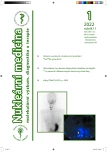Optimization of the timing of the whole body diagnostic scintigraphy with 131I in patients with differentiated thyroid cancers
Authors:
Libuše Quinn; Pavel Karhan; Pavel Koranda
Authors‘ workplace:
Klinika nukleární medicíny, LF UP Olomouc, ČR
Published in:
NuklMed 2022;11:10-14
Category:
Original Article
Overview
Introduction: Diagnostic whole-body scintigraphy with 131I (dxWBS) in patients with differentiated thyroid cancers (DTC) is an important procedure to verify radioiodine avidity of the DTC tissue before planning 131I therapy. Guidelines of the scientific societies (EANM, SNMMI, DGN) do not mention the exact time of dxWBS acquisition, 48 or 72 hours after 131I application are mostly recommended. The goal of our limited study was to assess which time interval after 131I application is the best for the detection of accumulating foci on dxWBS
Metod: We assessed 16 patients both 48 and 72 hours after application of 185 MBq of 131I during postablation dxWBS check-up. Planar scintigrams were acquired for 10 minutes at 48 hours and for 20 minutes at 72 hours post application. Images were performed with the gamma camera using HEGP collimator. Comparison of early and late scintigrams was performed visually, by calculation of foci contrast (T-B/B) and signal to noise ratio (SNR), respectively. Wilcoxon pair test was used to compare T-B/B and SNR in both acquisition times.
Results: Focal accumulation of 131I in the neck was detected in 10 patients; it was definitely evident only on late scintigrams in 4 patients. Average value of T-B/B increased from 0,219 on early to 0,592 on late scintigrams (p = 0,005); average value of SNR increased from 0,457 to 0,841 equally (p = 0,005).
Conclusion: We believe that dxWBS performed 72 hours after injection of 131I is diagnostically more effective even if the acquisition time is significantly longer.
Keywords:
therapy – differentiated thyroid cancers – 131I – diagnostic whole-body scintigraphy
Sources
- Haugen BR, Alexander EK, Bible KC, et al. 2015 American Thyroid Association Management Guidelines for Adult Patients with Thyroid Nodules and Differentiated Thyroid Cancer: The American Thyroid Association Guidelines Task Force on Thyroid Nodules and Differentiated Thyroid Cancer. Thyroid. 2016; 26 : 1-133
- Pacini F, Fuhrer D, Elisei R, et al. 2022 ETA Consensus Statement: What are the indications for post-surgical radioiodine therapy in differentiated thyroid cancer? Eur Thyroid J. 2022;11(1):e210046. doi: 10.1530/ETJ-21-0046. PMID: 34981741
- Silberstein EB, Alavi A, Balon HR, et al.. The SNM practice guideline for therapy of thyroid disease with 131I 3.0*. J Nucl Med. 2012;53 : 1633-1651
- DGN-Handlungsempfehlung (S1-Leitlinie) Iod-131-Ganzkorper - szintigraphie beim differenzierten Schilddruesenkarzinom (Version 5) Stand 1/2019 – AWMF-Registernummer: 031-013. https://www.nuklearmedizin.de/leistungen/leitlinien/docs/031-013_Ganzkoerperszintigraphie_2019.pdf
- Luster M, Clarke SE, Dietlein M, et al. Guidelines for radioiodine therapy of differentiated thyroid cancer. Eur J Nucl Med Mol Imaging 2008;35 : 1941-1959
- C. Durante, N. Haddy, E. Baudin, S., et al.. Long-Term Outcome of 444 Patients with Distant Metastases from Papillary and Follicular Thyroid Carcinoma: Benefits and Limits of Radioiodine Therapy. J Clin Endocrinol Metab. 2006;91 : 2892–2899
- Hilditch TE, Dempsey MF, Bolster AA, et al. Self-stunning in thyroid ablation: evidence from comparative studies of diagnostic 131I and 123I. Eur J Nucl Med Mol Imaging 2002;29 : 783–788.
Labels
Nuclear medicine Radiodiagnostics RadiotherapyArticle was published in
Nuclear Medicine

2022 Issue 1
Most read in this issue
- Bone scan detects metastases earlier than CT
- History, present and future of the use of 68Ge/68Ga generators – 2nd part
- Lympho 2021, Mariánské Lázně
- Optimization of the timing of the whole body diagnostic scintigraphy with 131I in patients with differentiated thyroid cancers
